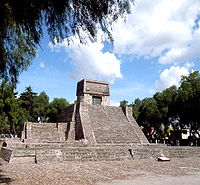Portal:Indigenous peoples of the Americas
(Redirected from Portal:Indigenous peoples of the America)
Discover Wikipedia using portals
Portal maintenance status: (June 2018)
|
The Indigenous peoples of the Americas PortalCurrent distribution of Indigenous peoples of the Americas The Indigenous peoples of the Americas are groups of people native to a specific region that inhabited the Americas before the arrival of European settlers in the 15th century and the ethnic groups who continue to identify themselves with those peoples. The Indigenous peoples of the Americas are diverse; some Indigenous peoples were historically hunter-gatherers, while others traditionally practice agriculture and aquaculture. In some regions, Indigenous peoples created pre-contact monumental architecture, large-scale organized cities, city-states, chiefdoms, states, kingdoms, republics, confederacies and empires. These societies had varying degrees of knowledge of engineering, architecture, mathematics, astronomy, writing, physics, medicine, planting and irrigation, geology, mining, metallurgy, sculpture and gold smithing. (Full article...) Selected article The Aztec /ˈæztɛk/ people were certain ethnic groups of central Mexico, particularly those groups who spoke the Nahuatl language and who dominated large parts of Mesoamerica from the 14th to 16th centuries. The Nahuatl words aztecatl [asˈtekat͡ɬ] (singular) and aztecah [asˈtekaʔ] (plural) mean "people from Aztlán", a mythological place for the Nahuatl-speaking culture of the time, and later adopted as the word to define the Mexica people. Often the term "Aztec" refers exclusively to the Mexica people of Tenochtitlan (now the location of Mexico City), situated on an island in Lake Texcoco, who referred to themselves as Mēxihcah Tenochcah [meːˈʃiʔkaʔ teˈnot͡ʃkaʔ] or Cōlhuah Mexihcah [ˈkoːlwaʔ meːˈʃiʔkaʔ]. Sometimes the term also includes the inhabitants of Tenochtitlan's two principal allied city-states, the Acolhuas of Texcoco and the Tepanecs of Tlacopan, who together with the Mexica formed the Aztec Triple Alliance which controlled what is often known as the "Aztec Empire". In other contexts, Aztec may refer to all the various city states and their peoples, who shared large parts of their ethnic history and cultural traits with the Mexica, Acolhua and Tepanecs, and who often also used the Nahuatl language as a lingua franca. In this meaning it is possible to talk about an Aztec civilization including all the particular cultural patterns common for most of the peoples inhabiting Central Mexico in the late postclassic period. Selected image American Buffalo Gold Bullion coin, based on the Indian Head nickel design of James Earle Fraser, modelled by three different native people, including Iron Tail image credit: United States Mint
General imagesThe following are images from various Indigenous peoples of the Americas-related articles on Wikipedia.
Selected biography Molly Brant (c.1736 – April 16, 1796), also known as Mary Brant, Konwatsi'tsiaienni, and Degonwadonti, was a prominent Mohawk woman in the era of the American Revolution. Living in the Province of New York, she was the consort of Sir William Johnson, the influential British Superintendent of Indian Affairs, with whom she had eight children. Joseph Brant, who became an important Mohawk leader, was her younger brother. After Johnson's death in 1774, Brant and her children returned to her native village of Canajoharie on the Mohawk River. A Loyalist during the American Revolutionary War, she fled to British Canada, where she worked as an intermediary between British officials and the Iroquois. After the war, she settled in what is now Kingston, Ontario. In recognition of her service to the Crown, the British government gave Brant a pension and compensated her for her wartime losses. Since 1994, Brant has been honored as a Person of National Historic Significance in Canada. She was long ignored or disparaged by historians of the United States, but scholarly interest in her increased in the late 20th century. She has sometimes been controversial, criticized for being pro-British at the expense of the Iroquois. A devout Anglican, she is commemorated on April 16 in the calendar of the Anglican Church of Canada and the Episcopal Church (USA). No portraits of her are known to exist; an idealized likeness is featured on a statue in Kingston and on a Canadian stamp issued in 1986. Did you know…
SubcategoriesRelated portalsThings you can do
Selected panoramaTopics
Recognized content
Featured articlesFormer featured articlesGood articles
Former good articlesDid you know? articles
In the News articlesAssociated WikimediaThe following Wikimedia Foundation sister projects provide more on this subject:
American indigenous language WikipediasAvañe'ẽ (Warani) · Aymar aru (Aymara) · ᏣᎳᎩ (Cherokee) · Chahta (Choctaw) · ᐃᔨᔫ (Cree) · ᐃᓄᒃ (Inuktitut) · Iñupiak · Kalaallisut (Greenlandic Inuit) · Mvskoke (Muscogee) · Nahuatlahtolli · Diné bizaad (Navajo) · Qhichwa Simi · Tsêhesenêstsestôtse (Cheyenne) Indigenous languages in Wikimedia Incubators: Alabama · Blackfoot · Chinook Jargon · Choctaw · Creek · Lakota · Micmac · Mohawk · Nheengatu · Northwestern Ojibwa · O'odham · Shoshoni · Unami-Lenape · Wüne pakina (Mapudungun) · Yucatec Maya · Central Alaskan Yup'ik · Zuni | |||||||||||||||||||||||||||||||||||||



